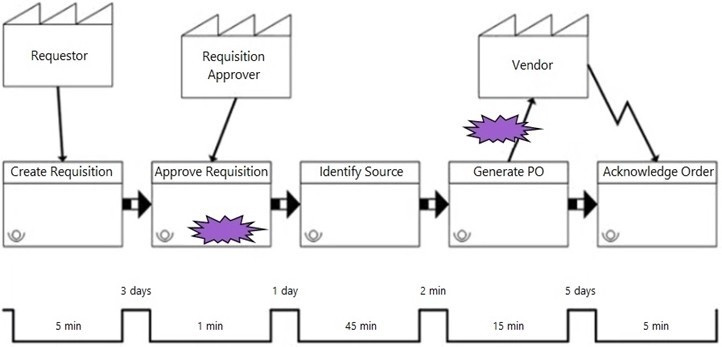Exam Details
Exam Code
:CCBAExam Name
:Certification of Competency in Business Analysis (CCBA)Certification
:IIBA CertificationsVendor
:IIBATotal Questions
:520 Q&AsLast Updated
:Jun 28, 2025
IIBA IIBA Certifications CCBA Questions & Answers
-
Question 431:
After a walk-through of the requirements specification with the business users, the group determines that five requirements are now mandatory due to new government regulations. What should the business analyst (BA) do following the meeting?
A. Update the priority of the requirements and record the reason for doing so
B. Ask the test analyst to ensure that test cases are only written to cover the new requirements
C. Escalate the decision to the project manager to confirm with all users again
D. Help the system analyst create a prototype of the requirements to demo to the users
-
Question 432:
A business analyst (BA) creates the following diagram as part of current state analysis activities.

What does a diagram of this type help users to understand?
A. Decision-making
B. Regulatory compliance
C. Business capability
D. Process improvement
-
Question 433:
A business analyst (BA) has executed the last planned workshop in a series in order to verify requirements. All issues have been logged in an issues register. What technique is used to manage and resolve the outstanding issues?
A. Requirements documentation
B. Requirements analysis
C. Metrics and KPIs
D. Item backing methods
-
Question 434:
A company has bought a customizable software product and the vendor's business analyst (BA) is visiting the company's office to perform a requirements assessment. The business sponsor expresses an interest in improving a specific process that is in scope. What should the BA do?
A. Develop a data model
B. Create a process model
C. Review data flow diagrams
D. Observe the activity
-
Question 435:
A business analyst (BA) plans to organize a focus group to bring all the interested parties together and discuss the issues and possible risks for the new initiative. Due to the geographical differences of each participant a videoconferencing service will be used to satisfy stakeholder preferences. Which approach is the BA defining?
A. Stakeholder analysis
B. Issue management
C. Release planning
D. Stakeholder collaboration
-
Question 436:
The Chief Executive Officer (CEO) is concerned about how two client bases are going to be integrated and serviced in the newly formed company after a merger. A project has been initiated to implement a Customer Relationship Management (CRM) system for the new company that will contain the client information from both companies. What must the business analyst (BA) do to address the concerns of the CEO?
A. Demonstrate the functionality of the new CRM
B. Reuse requirements models from each company
C. Ensure all regulatory requirements are documented
D. Create merged viewpoints of the requirements
-
Question 437:
Which stakeholder in the solution assessment task will provide information on technical constraints that could limit the solutions that may be implemented?
A. Project manager
B. Suppliers
C. Sponsor
D. Operational support
-
Question 438:
A business analyst (BA) was asked to send the requirement details to the project manager (PM), director, vice president (VP), and Chief Information Officer (CIO). The BA shares the complete set of requirements to the PM and director, while creating a summarized version for the VP and CIO. Which aspect of requirement specification and modeling was the BA performing?
A. Perform stakeholder analysis
B. Organize requirements categories
C. Determine approval authority
D. Implement appropriate level of abstraction
-
Question 439:
A company wants to increase its market share in the industry and its Board has prioritized capabilities that need to be implemented to achieve the goal. The business requirements for the top priority were signed off and the solution design has been completed. Due to technical constraints, it is not feasible to implement all the requirements at the same time. What must the business analyst (BA) do to deal with this situation?
A. Redefine the business requirements associated with each implementation
B. Recommend a reduction in the project scope
C. Allocate requirements to different releases
D. Ensure all requirements are traceable using a matrix
-
Question 440:
A business owner has identified a high priority requirement that needs to be implemented immediately. The project manager has asked the business analyst (BA) to perform an impact analysis of this change. Which factor will the BA need to consider?
A. Number of systems being affected by the requirement
B. Original source of the requirement
C. Method of requirement communication
D. Selection of the elicitation for the requirement
Tips on How to Prepare for the Exams
Nowadays, the certification exams become more and more important and required by more and more enterprises when applying for a job. But how to prepare for the exam effectively? How to prepare for the exam in a short time with less efforts? How to get a ideal result and how to find the most reliable resources? Here on Vcedump.com, you will find all the answers. Vcedump.com provide not only IIBA exam questions, answers and explanations but also complete assistance on your exam preparation and certification application. If you are confused on your CCBA exam preparations and IIBA certification application, do not hesitate to visit our Vcedump.com to find your solutions here.